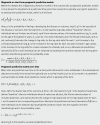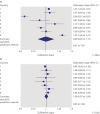External validation of clinical prediction models using big datasets from e-health records or IPD meta-analysis: opportunities and challenges
- PMID: 27334381
- PMCID: PMC4916924
- DOI: 10.1136/bmj.i3140
External validation of clinical prediction models using big datasets from e-health records or IPD meta-analysis: opportunities and challenges
Erratum in
-
External validation of clinical prediction models using big datasets from e-health records or IPD meta-analysis: opportunities and challenges.BMJ. 2019 Jun 25;365:l4379. doi: 10.1136/bmj.l4379. BMJ. 2019. PMID: 31239248 Free PMC article. No abstract available.
Abstract
Access to big datasets from e-health records and individual participant data (IPD) meta-analysis is signalling a new advent of external validation studies for clinical prediction models. In this article, the authors illustrate novel opportunities for external validation in big, combined datasets, while drawing attention to methodological challenges and reporting issues.
Conflict of interest statement
Competing interests: None declared.
Figures






References
-
- Steyerberg EW. Clinical prediction models: a practical approach to development, validation, and updating.Springer, 2009. 10.1007/978-0-387-77244-8. - DOI
-
- Royston P, Moons KGM, Altman DG, Vergouwe Y. Prognosis and prognostic research: Developing a prognostic model. BMJ 2009;338:b604 10.1136/bmj.b604 pmid:19336487. - DOI - PubMed
-
- Steyerberg EW, Moons KG, van der Windt DA, et al. PROGRESS Group. Prognosis Research Strategy (PROGRESS) 3: prognostic model research. PLoS Med 2013;10:e1001381 10.1371/journal.pmed.1001381 pmid:23393430. - DOI - PMC - PubMed
-
- Anderson KM, Odell PM, Wilson PW, Kannel WB. Cardiovascular disease risk profiles. Am Heart J 1991;121:293-8. 10.1016/0002-8703(91)90861-B pmid:1985385. - DOI - PubMed
-
- Hippisley-Cox J, Coupland C, Vinogradova Y, et al. Predicting cardiovascular risk in England and Wales: prospective derivation and validation of QRISK2. BMJ 2008;336:1475-82. 10.1136/bmj.39609.449676.25 pmid:18573856. - DOI - PMC - PubMed
MeSH terms
Grants and funding
LinkOut - more resources
Full Text Sources
Other Literature Sources
Medical
